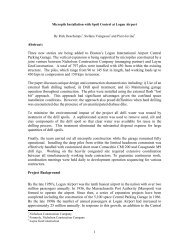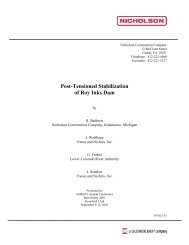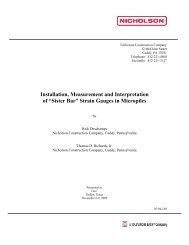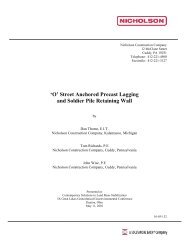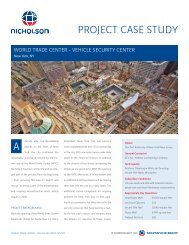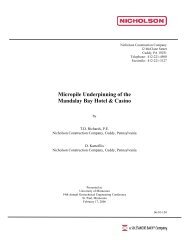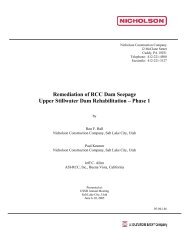Rehabilitation of a Failing Anchored Retaining Wall - Nicholson ...
Rehabilitation of a Failing Anchored Retaining Wall - Nicholson ...
Rehabilitation of a Failing Anchored Retaining Wall - Nicholson ...
Create successful ePaper yourself
Turn your PDF publications into a flip-book with our unique Google optimized e-Paper software.
Richards/Thome, Page 7<br />
Figure 1 <strong>Rehabilitation</strong> Typical Design Section<br />
Soldier piles were placed in 0.9 meter predrilled holes. To reduce risk <strong>of</strong> any slurry wall<br />
movement some shafts were skipped and then drilled on another shift. Slurry wall panels<br />
were monitored with a total station approximately every ten minutes during drilled shaft<br />
installation by shooting prisms mounted to the slurry wall. Readings continued on the wall<br />
every half an hour until the soldier piles were placed in the drilled shafts and filled with<br />
structural concrete.<br />
Due to the precast lagging and especially the precast wales, accurate soldier beam placement<br />
was required. 10 meter long templates were made that would support the beams in the drilled<br />
shafts prior to the initial set <strong>of</strong> the structural concrete.<br />
Prior to setting the concrete waler, existing anchor locations on the slurry wall were compared<br />
to proposed anchors through the new wall. If any <strong>of</strong> the new anchors were expected to hit an<br />
existing anchor bearing plate, the waler would be slid to one side if clearance <strong>of</strong> the bearing<br />
plate could be accomplished. As a last resort a portion <strong>of</strong> the bearing plate would be burned





